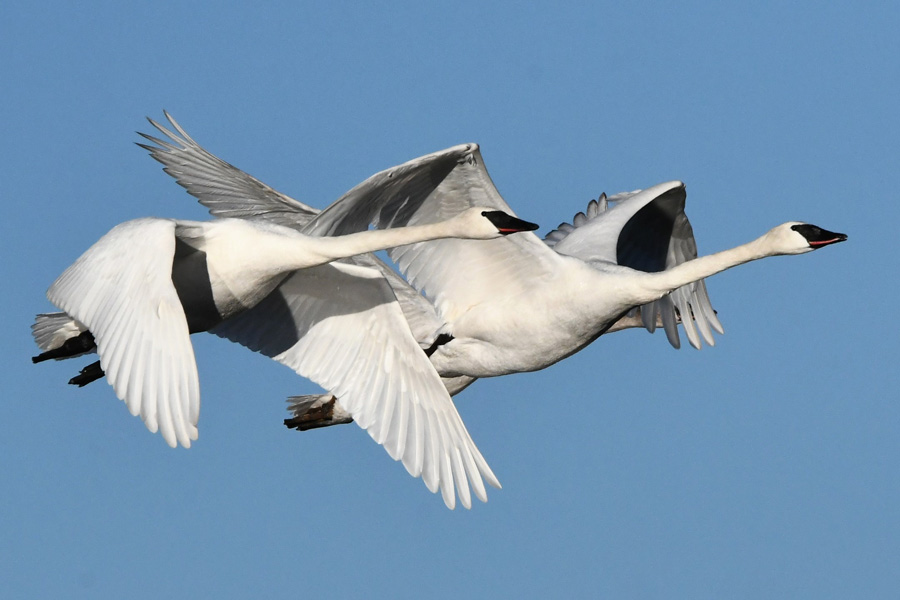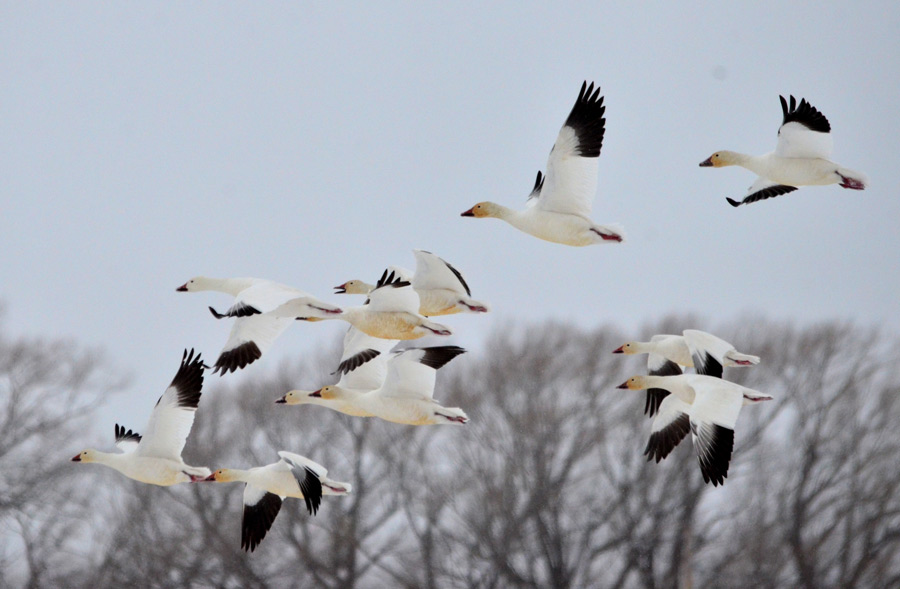A busy, exciting display of big white birds at Market, Mud Lake and Camas Wildlife Refuge
Published at | Updated at
It has been an interesting spring with people telling me about all the fields covered with “huge snow geese.” I usually ask them to describe what they saw by asking if they have black on their wings.
“Nope, but they are snow geese!” they reply.
“Do they have a pink or orange bill?” I ask.
“No, but they are big geese.”
To the eye of novice birders or non-birders, any big white bird can be a snow goose, but all Snow Geese have black wingtips with light-colored bills and feet. Trumpeter swans, many that winter in eastern Idaho, have black feet and a black bill. Their black bills wrap around the eye and run a straight line from the tip to the top of their head. Tundras are smaller than the Trumpeters with black legs and bills with a small yellow basal spot usually on both sides of the bill which has a slight curve. Snow geese, which are much smaller than the swans, have pink- or orange-colored bills and feet. The bill is rather short on a round head.
The sounds coming from the incoming flocks usually alert me well before I can see them. Of course, the Trumpeters sound much like a trumpet while the Tundras have a mellow, high-pitched cooing “woo-hoo, woo-woo” sound. Snow geese fly in shallow “V’s” called “wavies” and are very noisy with constant loud, double-noted “houck-houcks.”

Well, this week has been a good week to see the difference between snow geese and the two species of swans that migrate through eastern Idaho. Thousands of Tundra and Trumpeter swans were often seen in large flocks from the Osgood area to Camas National Wildlife Refuge, while Snow geese could be seen flying high overhead.
On Wednesday, I watched mixed flocks of the two species of swans landing in small pockets of open water in Ponds 3 and 4 at Market Lake. While taking pictures of them, I heard the unmistakable call of hundreds of Snow geese as they flew in from the American Falls Reservoir. They flew past Market Lake, only to turn around and come back, circling twice and then heading directly to Mud Lake.
During the six hours I spent at Market Lake, hundreds of Tundra swans dropped in from high altitudes. It was amazing to watch them drop straight down, not moving a wing until they were only a few feet above the water. They circled once and landed on the water. It appeared that they were very thirsty because they had their bill in the water almost before their feet got wet.
In the flocks of Snow geese, I noticed several “dark” geese breaking up the v’s of white ones. Most of them were the “blue” morph of the Snows and are recognized by their white head and neck with bluish-gray bodies. Other dark ones may sometimes be a single or a small flock of Great white-fronted geese that are dark, except a white face and black bars on their belly.
As you study a flock of Snow geese, you will notice some smaller geese about half the size of the larger ones. These are the Ross’s geese and are found in both the white and blue variations.

The Northern pintail duck migration is winding down a little, but they are being replaced by Northern shovelers, Blue and Green teal, American wigeon, Lesser scaup and Ring-billed ducks with others soon to follow.
As the ice recedes from the area ponds and lakes, the water will become very busy with the migrating waterfowl, followed by the many shorebirds. For the next two months, Market Lake, Mud Lake and the Camas National Wildlife Refuge will be a busy, exciting place to visit. Go out, find some open water and enjoy the show.

Living the Wildlife is brought to you by Yellowstone Teton Territory. Experience 7,500 square miles of untamed wilderness in Eastern Idaho's Yellowstone Teton Territory. Where majestic peaks meet endless adventure, your perfect outdoor escape is waiting. Start planning at YellowstoneTeton.com.



